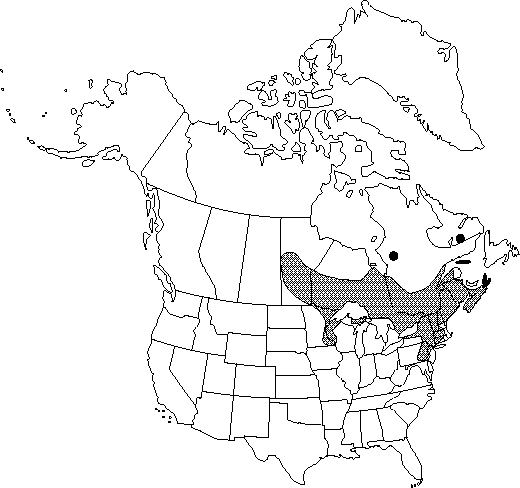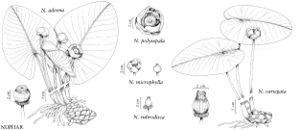Nuphar microphylla
Rhodora 19: 111. 1917 (as microphyllum).
Rhizomes 1-2 cm diam. Leaves mostly floating, occasionally submersed; petiole flattened to filiform. Leaf blade abaxially often purple, adaxially green to greenish purple, broadly elliptic to ovate, 3.5-10(-13) × 3.5-7.5(-8.5) cm, 1-1.5 times as long as wide, sinus 2/3 or more length of midrib, lobes divergent and forming V-shaped angle; surfaces abaxially glabrous to densely pubescent. Flowers 1-2 cm diam.; sepals 5(-10), abaxially green to adaxially yellow toward base; petals broadly spatulate and thin, or notched and thickened; anthers 1-3 mm, shorter than filaments. Fruit yellow, green, brown, or rarely purple, mostly globose-ovoid, occasionally flask-shaped, 1-2 cm, smooth basally, faintly ribbed toward apex, deeply constricted below stigmatic disk, constriction 1.5-5 mm diam.; stigmatic disk red, 2.5-7 mm diam., with 6-10 deep crenations; stigmatic rays 6-11, linear, terminating 0-0.2 mm from margin of disk. Seeds ca. 3 mm. 2n = 34.
Phenology: Flowering summer–early fall.
Habitat: Ponds, lakes, sluggish streams, sloughs, ditches, and occasionally tidal waters
Elevation: 0-400 m
Distribution

Man., N.B., N.S., Ont., Que., Conn., Maine, Mass., Mich., Minn., N.H., N.J., N.Y., Pa., Vt., Wis., Europe, n Asia.
Discussion
Intermediates between Nuphar microphylla and N. variegata, probably of hybrid origin, are treated as N. rubrodisca. A form with ten sepals (Nuphar microphyllum forma multisepalum Lakela) occurs in northeastern Minnesota. Recent observations of the Eurasian N. pumila (Timm) de Candolle by C. B. Hellquist in Siberia suggest that Beal's lumping of N microphylla under N. lutea subsp. pumila (Timm) E. O. Beal should be further studied.
Selected References
None.
